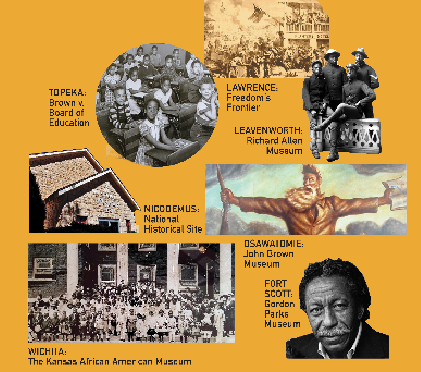African American history mapped across Kansas
From stops on the Underground Railroad to the headquarters of abolitionist John Brown, a new history trail in Kansas spotlights sites that shaped history in Kansas and the nation.
The Kansas African American History Trail launched earlier this year at its Wichita site: The Kansas African American Museum (TKAAM), housed in the former Calvary Baptist Church at 601 N. Water. Once part of a thriving black neighborhood, the 1917 building is on the National Register of Historic Places.
The trail – which organizes eight already established historical sites – is the result of a $135,000 grant from the Institute of Museum and Library Services awarded to TKAAM in 2016.
The sites are not only educational but inspiring, said Ted Ayres, project coordinator for the trail and president of TKAAM’s board. Ayres, who led TKAAM’s effort in becoming a repository for a collection of photographer Gordon Parks’ works, has long been interested in history. Parks was a prolific internationally known photographer, filmmaker and author who wrote about his experiences growing up in segregated Fort Scott, Kansas; the Gordon Parks Museum in Fort Scott is on the trail.
“By studying and learning of the past,” Ayers said, “we can be enriched, entertained and informed with the hope of doing more, doing better.”
At the trail site in Osawatomie, visitors can stand in the cabin that served as abolitionist John Brown’s headquarters. It was disassembled and moved to its current site in John Brown Park, where Brown and his band of 30 to 40 abolitionist fighters took on a proslavery militia of more than 250 men in August 1856, several months after Brown and supporters had killed five slavery supporters in Pottwatomie in response to the sacking of Lawrence. It was a historic Bleeding Kansas fight that some say helped lead to the start of the Civil War.
In Topeka, visitors can stop in at two sites: the former all-black Monroe Elementary School that is now the Brown v. Board of Education of Topeka National Historic Site and the Historic Ritchie House, a stop on the Underground Railroad. Ayres, the former general counsel for the Kansas Board of Regents and then Wichita State University, said he considers the 1954 Supreme Court ruling commemorated in the Monroe School to be one of the top five legal decisions ever made.
At the Ritchie House, visitors can learn about John and Mary Ritchie, suffragette and racial equality supporters, who helped black freedom seekers on the Underground Railroad. John Ritchie also helped write Kansas’ constitution.
In Leavenworth, the trail stops at the Richard Allen Cultural Center and Museum, named for the founder of the African Methodist Episcopal church. Visitors can step into the former home of William Bly, a Buffalo Soldier. The museum highlights the all-black regiment formed after the Civil War and other notable African Americans, including Colin Powell, who was once stationed at Fort Leavenworth.
In Lawrence, at what’s known as Freedom’s Frontier National Heritage Area, visitors will learn about some more painful moments in history – including the effects of Kansas choosing to join the union as a free state, the lynchings of African Americans and the rise of the Ku Klux Klan in Kansas.
The six trail sites in eastern Kansas could easily be visited in a two-day trip, Ayres said. The lone western Kansas trail site is the Nicodemus National Historic Site, the oldest and only remaining post-Civil War African American settlement west of the Mississippi. At least three staff members at the site are descendants of those early settlers, Ayres said.
There are several other points of interest in African American history in Kansas, Ayres noted, but the trail features sites that are open regularly and staffed. More sites are expected to be added to trail, he said.
Trail sites
The Kansas African American Museum, 601 N. Water, 316-265-6953, tkaamuseum.org. Museum features blend of art and artifacts of African Americans.
Nicodemus, 304 Washington Ave., Nicodemus, 785-839-4321,
nps.gov/nico. Five historic buildings and annual Emancipation/Homecoming Celebration each July embody the Black West Experience.
Brown v. Board of Education National Historic Site, 1515 SE Monroe St., Topeka, 785-354-4273, nps.gov/brvb. Former segregated schoolhouse highlights U.S. Supreme Court’s famous “separate but equal” ruling.
Historic Ritchie house, 1116 and 1118 SE Madison, Topeka, 785-234-6097. Underground Railroad station and former home of pioneers in struggle for racial equality.
Freedom’s Frontier National Heritage Area, 200 W. 9th St., Lawrence, 785-865-4499, freedomsfrontier.org. Former Carnegie Library focuses on Civil War on the western frontier.
The Richard Allen Cultural Center and Museum, 412 Kiowa St., Leavenworth, 913-682-8722. Explore the black experience in Leavenworth.
John Brown Museum State Historic Site, 1000 Main St., Osawatomie, 913-755-4384, adaircabin@osawatomieks.org. Cabin and battle site associated with radical abolitionist John Brown.
Gordon Parks Museum, 2180 S. Horton, Fort Scott, 620-223-2700, gordonparkscenter.org. Museum honors first black photographer for Life magazine and first African American to direct a major movie, The Learning Tree.
A map with more details on each site and more information about the trail can be found at tkaahistorytrail.org.
Contact Amy Geiszler-Jones at algj64@sbcglobal.net











